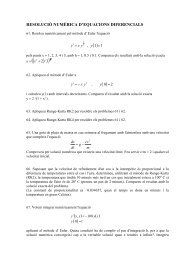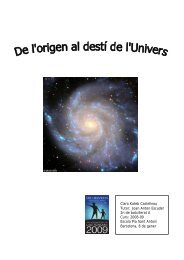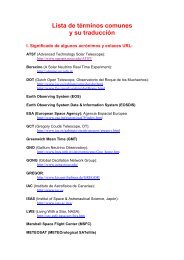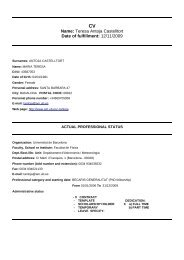Universitat de - Departament d'Astronomia i Meteorologia ...
Universitat de - Departament d'Astronomia i Meteorologia ...
Universitat de - Departament d'Astronomia i Meteorologia ...
Create successful ePaper yourself
Turn your PDF publications into a flip-book with our unique Google optimized e-Paper software.
Chapter 5<br />
Radio and optical observations<br />
5.1 Introduction<br />
After the cross-i<strong>de</strong>ntification of catalogs presented in the previous chapter, the next<br />
logical step of the process 1 is to obtain accurate radio positions, that will be ex-<br />
plained in Sect. 5.2, and then search for possible optical counterparts, that will be<br />
presented in Sect. 5.3. A discussion on the obtained results is carried out in Sect. 5.4,<br />
while we state our conclusions in Sect. 5.5.<br />
5.2 Radio observations<br />
The main goal of the radio observations was to obtain accurate sub-arcsecond po-<br />
sitions, but we also wished to monitor the variability of radio flux and spectrum<br />
of our targets. On the other hand, it was also important to investigate the source<br />
structure beyond the NVSS resolution. For REXBs, most of the source flux <strong>de</strong>n-<br />
sity is expected to be concentrated in a compact core plus possible arcsecond or<br />
sub-arcsecond exten<strong>de</strong>d features. By observing each target with the VLA in A con-<br />
figuration, we were able to verify to what extend our sources were in<strong>de</strong>ed compact,<br />
and to look for possible elongations or jets.<br />
To this end, multi-frequency and multi-epoch observations of the Group 1 sources<br />
1 Published in Pare<strong>de</strong>s, J. M., Ribó, M., & Martí, J. 2002, A&A, 394, 193.<br />
131






